THE CLIMATE ASPECT IN THE ARGENTINE UFO CASE
By CARLOS FERGUSON
Among the large number of variables to be analyzed in the UFO question in Argentina, it was necessary to minimally determine the climatic conditions at the time of the Argentine cases.
Already in the 1970s, Claude Poher and Jacques Vallée had confirmed that around 25% of French official reports contain information about meteorological conditions.
A simple statistical study (on 258 French cases) indicates that the phenomenon is seen LESS frequently when weather conditions are adverse.
The statistics were computed for French and non-French cases separately, and were found to be almost similar, with 57% of all sightings made under clear sky conditions, 15 or 20% under partly cloudy skies, 10% under partly cloudy skies, cloudy and 8% with overcast skies, and the remaining small percentage with rain.
This study is fundamental, since added to other aspects, we can guess what witnesses really see, under what conditions and for how long.
And also indirectly determine if they have been confused with identifiable phenomena in distance parameters and climatic conditions (atmospheric visibility).
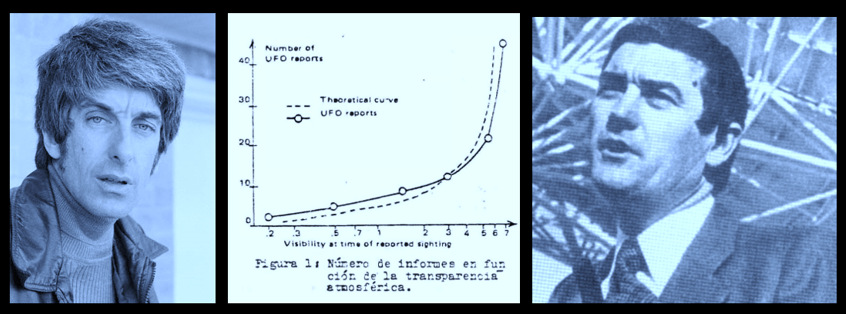
TYPICAL EXAMPLE OF UFO CAUGHT AT MORE THAN 1,500 METERS
Just as an example, the photographic case recorded in Namur (Belgium), on June 5, 1955. This event was reviewed by the great Aimé Michel in his study called: “Three genuine photographs – Flying saucer review – vol. 7, no. 1, January-February 1961”
In it, an anonymous witness (worker) was able to capture with his camera the presence of a flying saucer in 3 images. The photographs were analyzed by a meteorologist and confirmed as authentic. The expert determined that the vapor trail that was perceived was caused by authentic atmospheric condensation, which could not have formed at less than an altitude of 1,500 meters (approximately 5,000 feet). Therefore, the object must have had dimensions around 12 meters (approximately 40 feet). A professional astronomer – in turn – analyzed the negative, and concluded that the photos were not doctored (there was no editing).
According to the witness, the object accelerated and stopped. As it decelerated, it descended and the contrail formed. Then he rose again. He finally accelerated as the vapor trail disappeared, and ended up getting lost at high speed.
We are looking at images achieved at a great distance from the camera, with the corresponding conjunction of atmospheric visibility.

ARGENTINA DATA
The data that readers will see in this article, as well as the work I have recently published on electromagnetic effects, the law of time, effects on vision, effects of sound, effects on skin and paralysis, are not opinion product. personal or hypothesis.
On the contrary, they are raw data from the most significant and extensive catalog to date in Argentina, that of “Desembarcos”, which includes the study since 1947, entirely classified under international parameters, with more than 30 years of dedication. Its sources of origin are global.
There is no other similar catalog in Argentina. Those who offer different versions of it must at least have a similar study to compare it. As long as this does not happen, this information is what really emerges from our country as a whole, beyond some nonsense, crazy theories, or non-existent “records” that some try to promote.
I have already pointed out in other notes the investigative failure in different missing data in the cases.
An example was what happened in a period taken from 1991 to 2002, from the archives of the Argentine Ufology Network (RAO).
As central coordinator, I carried out a statistical analysis of the cases we had on file, especially those coming from ufological participants. These cases were published in all the bulletins at that time and exceeded 1,000.
The surprise was huge: in 8 items of Dr. Hynek’s Strangeness and Believability test, we found dramatic missing elements (we see them in red in the graph below).
Weather conditions were the worst, as in 95 out of 100% of cases no weather conditions were reported.
This shows a notable omission in research and surveys.
For this reason, it is essential to have the greatest casuistry and most comprehensive data, to confront the rumors and disclosures that we face in Ufology Argentina.
Evidently, the climate factor is not usually used or mentioned in the overwhelming majority of reports.

(Graphic C.Ferguson)
ATMOSPHERIC CONDITION AT LANDINGS
In the landing catalog we also have the same situation as in the RAO cases already mentioned.
The atmospheric condition of the cases is another of the great gaps.
One option – impossible due to the high cost – was to request climate information on the days of the cases, from the National Meteorological Service.
This has two difficulties: the age of many cases and the high cost involved in finding out information on 2,000 cases.
These are tasks that an official body dedicated to the subject could do (by the way, an official body efficient on the subject, and not like the one we currently have in Argentina).
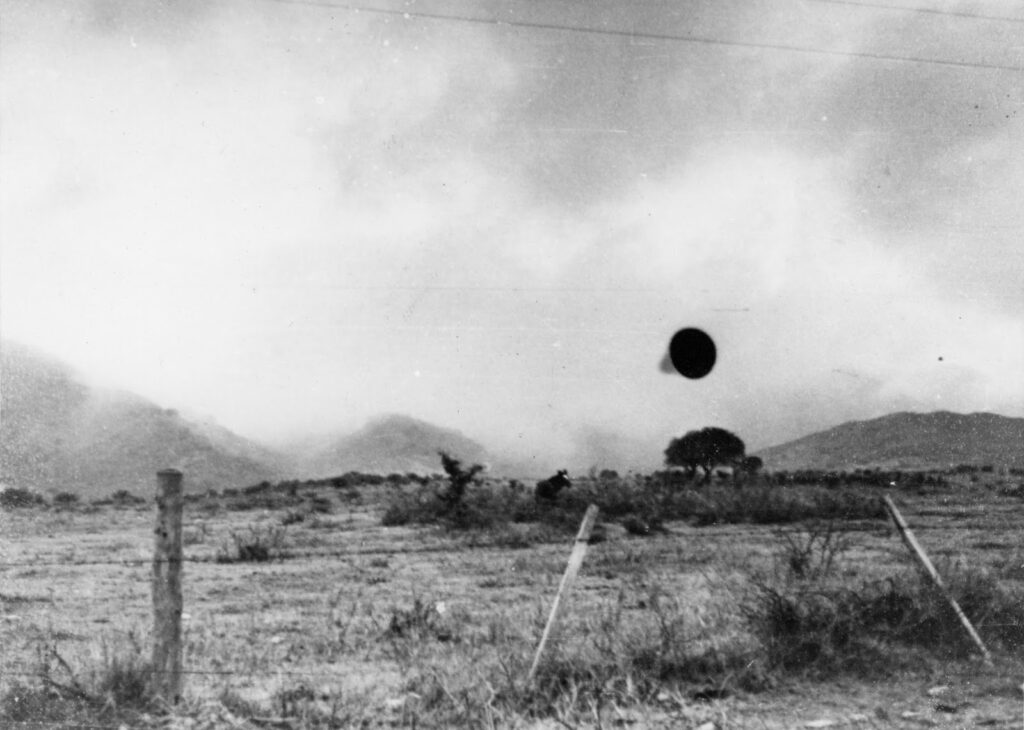
DIFFERENCE BETWEEN ATMOSPHERIC WEATHER AND CLIMATE
First of all, it is key to understand the difference between weather and climate.
In the first there are 3 factors to take into account: precipitation, wind and temperature.
Climate is the weather that prevails in a place over a long period of time, depending on other factors.
Therefore, we are talking about “atmospheric condition” predominantly.
It is there where we find the state of the atmosphere in short periods, generally hours or a few days. This is where we aim to study UFO complaints.

ATMOSPHERIC CONDITION IN ARGENTINE CASES
Given the impossibility of having all the data of almost 2,000 cases of landings, the way was to determine, through different means, the atmospheric conditions they had.
For this, the few cases where these conditions were detailed were taken. And to this were added the events that we were able to determine by indirect means (including some photographic cases that allow us to detect benign climatic aspects).
The initial sample that had the atmospheric condition of Argentine cases indicated was similar – in percentage – to the study by Poher and Vallée.
In any case, to the primary data we had, we were able to add others where the reference, directly or indirectly, did not tell us about an adverse climatic condition.
In the total number of landing cases, the sources of their origin include data from field researchers, personal communications and investigations, cases disseminated in all press media (radio, television, newspapers, internet), official media, among others.
The sample where we have defined the climatic conditions covers all of the Argentine provinces. Thousands of kilometers from North to South and East to West with all climates (in Argentina we have humid, dry, temperate, cold and tropical heat climates).

(Graphic: C.Ferguson)
Of the total we can confirm 933 data with acceptable or good weather and 32 with bad conditions (Total 965).
This is 54% of the total landing cases in Argentina.

ADDITIONAL PROBABLE DATA
In addition to this, I have reviewed the more than 1,000 remaining cases, in order to find what we can consider as “probable” climate data.
We can call probable the cases where we can infer that the climatic conditions were moderately acceptable.
To do this we can find some descriptions of the witnesses that can help us:
A – Hanging clothes out in the open to dry.
B – Riding
C – Taking something outdoors
D – Looking at the sky
E – Working on the tractor
F – Fishing or hunting (although we also have cases of people doing it in so-called adverse climates, but it is not the generalization)
G – Walking in recreation
H – Repairing the home outside
Etc. In general, everything described is carried out under minimally “acceptable” conditions.
Photographic events where those same conditions are reflected in the images have also been included.
Once this is obtained, we can add 114 new cases of acceptable weather.
This gives us a total of 1079 Argentine cases of landings, from which we can infer a climatic condition.

(C.Ferguson – Pixabay Images)
TOTAL OF ACCURATE AND PROBABLE DATA
We see the activity for decades. The preponderant peaks are surely due to the greater activity of researchers from the 1960s to the year 2000.
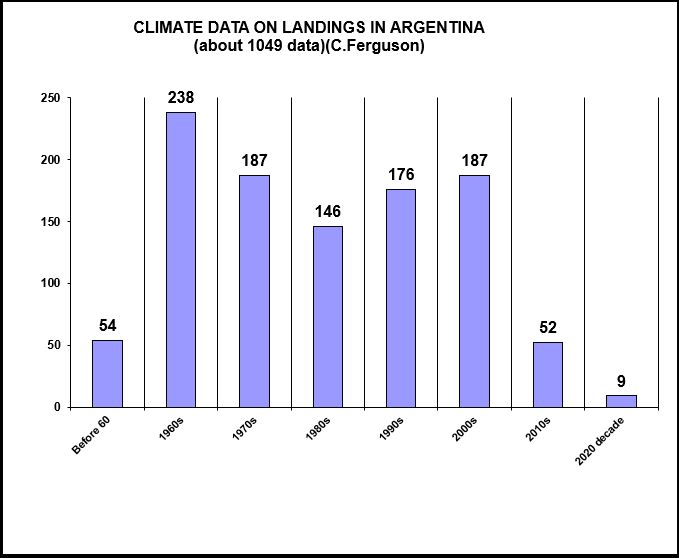
The decrease since then implies a lot of missing data due to the priority of the majority of UFO participants, to disseminate, ignoring general information about the cases.
By adding the probable data, the existing gap between the “good” and “bad” climate data is confirmed.
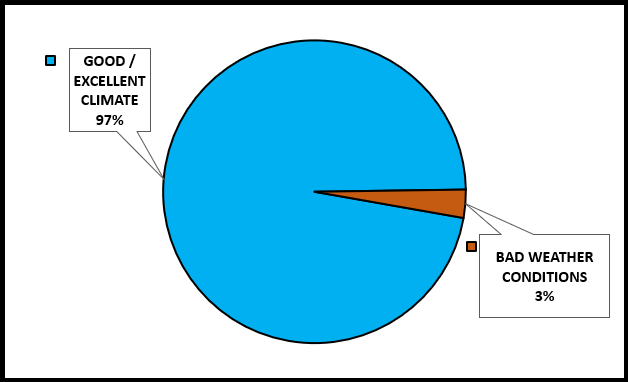
CLIMATIC CONDITION AND DISTANCE FROM THE WITNESS
We know that there are meteorological factors that influence visibility. An average visibility depends on them according to their presence:
With Precipitation (visibility of 50 to 200 meters).
With Fog, fog (visibility between 500 and 1,000 meters – weak / between 50 and 500 meters – moderate and less than 50 meters – dense.
With dust and sand (visibility depending on wind intensity)
With Smoke, Dew, Smog, Blizzard (varied visibility) (QUOTE 1)
Beyond these, it was important to determine in this catalog how many cases there were where we had two conditions:
1 – Atmospheric condition
2 – Distance from the witness to the UFO
I was able to extract 448 cases (432 with conditions that we can consider good or very good and only 16 with bad conditions).
In view of this data, and even though there is a notable difference between the two, we can infer the average viewing distance in good and bad weather events:
The average of events with “good weather” allow an average visualization of almost 539 meters, while those with “bad weather” reach an average of 162 meters.
The observation of UFO cases is in accordance with the prevailing atmospheric conditions.
We are not dealing with fantasies, hallucinations or alcoholism.

UFO REPORTS IN DIFFERENT ATMOSPHERIC CONDITIONS
This is a very interesting topic, for future additional studies, on the cases received in different geographical locations in Argentina.
We already know that beyond population density, and by dividing the country into 4 clear geographical regions, the number of observations per inhabitant per square km has preponderance, in largely unpopulated spaces, strictly complying with the First Negative Law of Dr. Jacques Vallée. This happens perfectly in our country.
In countries with geographical limitations, these studies are not more likely to be carried out.
Argentina enjoys – in that sense – the privilege of having a very large territory and different climates.
These are additional details, but we will analyze the visibility for witnesses in different geographic areas and climates. The case of BUENOS AIRES (central area) and PATAGONIA (in the extreme south).
The climate varies at different times of the year, but we will only focus on the general.
In Buenos Aires we have a population density of 57 inhabitants per square kilometer, while in Patagonia, the density is only 2.2%.
In the province of Buenos Aires there are 4 different types of microclimates, with temperate predominating. Precipitation ranges from 600 to 1,000mm in much of the metropolitan area of Buenos Aires.
In Patagonia, the variety of climates is notable, with temperate to cold predominating, with temperatures that decrease noticeably from north to south (the Patagonian Andes also significantly influence this varied climate). The dry winds after the Patagonian forests have generated an arid and cooler desert in the steppe. That place is constantly buffeted by winds, some of which exceed 100 km ph.
As we see in the illustrative graphs, sunny, cloudy or precipitation days are very different, as well as the “Compass Rose”.

It was interesting to see to what extent, in such different areas, the visibility of witnesses when perceiving an alleged UFO is manifested.
To do this, we have taken all the cases where we have “Distance” and “Meteorological data” in Buenos Aires and Patagonia.
We see the graph that shows us the percentages of distances, which are very coincident between both. There seem to be no differences between them.

And going deeper into the matter, I have made a calculation of the average visibility of both places (Buenos Aires and Patagonia).
There emerges a truly striking fact: the average UFO visibility distance in Buenos Aires is 424 meters, and that of Patagonia is 440 meters.
This may bring us closer to a primary conclusion: there do not seem to be differences in visibilities even in such disparate climatic areas (in general). A subsequent study will warrant comparing the reports according to the seasons.

CONCLUSIONS
A – Even without having all the necessary information, the data from Argentina would indicate that UFO events occur mostly in good or acceptable meteorological conditions. The study by Vallée and Poher had already been stipulated in their study in the 70s, although they had national meteorology archives.
B – This largely minimizes the possibility that the witnesses have been confused with phenomena identifiable in distance parameters and climatic conditions.
C – In the cases studied in Argentina (where we have distance and climate data), the average visibility in good weather conditions exceeds in visibility – as expected – those in bad conditions. This dismisses those detractors who argue that the UFO cases are pure “invention of believers.”
Astrophysicist Claude Poher rightly points out:
“Reading thousands of available observation reports reveals that the UFO phenomenon is alleged to have been observed at all distances (from a few meters to several tens of kilometers). Consequently, this is a truly observed phenomenon, all the more so it should be noted the more transparent the Earth’s atmosphere is at the time of observation. A basic statistical study on the state of the cloud cover at the time of observation reveals that this property seems to hold true both in France and in other countries. (QUOTE 2)
And he formulates as a hypothesis that:
«The phenomenon is “statistically equivalent” to the observation of objects (in the optical sense of the word), which pass through the atmosphere: their number per unit of volume is constant in thirty years».
Astrophysicist Pierre Guerín confirms it:
“Poher established that UFO observations reach greater distances the better the visibility (estimated according to meteorological conditions)…in addition, witnesses see more UFOs the clearer the sky is. This argues decisively in favor of the physical reality of the phenomenon, since it obeys the laws of optical vision. (QUOTE 3)
D – Visibility in disparate climatic zones of Argentina (Buenos Aires and Patagonia) does not seem to show differences (we are referring more than anything to the observation of a body without terrain obstacles, where in Patagonia, it would enjoy almost complete amplitude ). What defines an observation is the climatic factor in each place where it occurs. (QUOTE 4)

EPILOGUE
It is essential to analyze the most complete cases, to determine variables that – in general – are not taken into account by the vast majority of UFO participants and disseminators.
These boast of carrying out “investigations”, when in reality they are simple reports prioritizing shocking data or “scoops”, instead of data that they consider “boring”.
But if we agree that the axis of the cases are mainly the testimonies, it is key that methodologies are applied in the survey.
Each witness in the hands of simple divulgers is a quasi-loss of the case, generating contamination of the story.
Among the details most missing from the reports is the atmospheric condition – as demonstrated in a simple case information survey.
Each new researcher will be able to make a fundamental contribution to the topic, when they consider the need to apply basic criteria in the ufological survey.
Carlos Ferguson
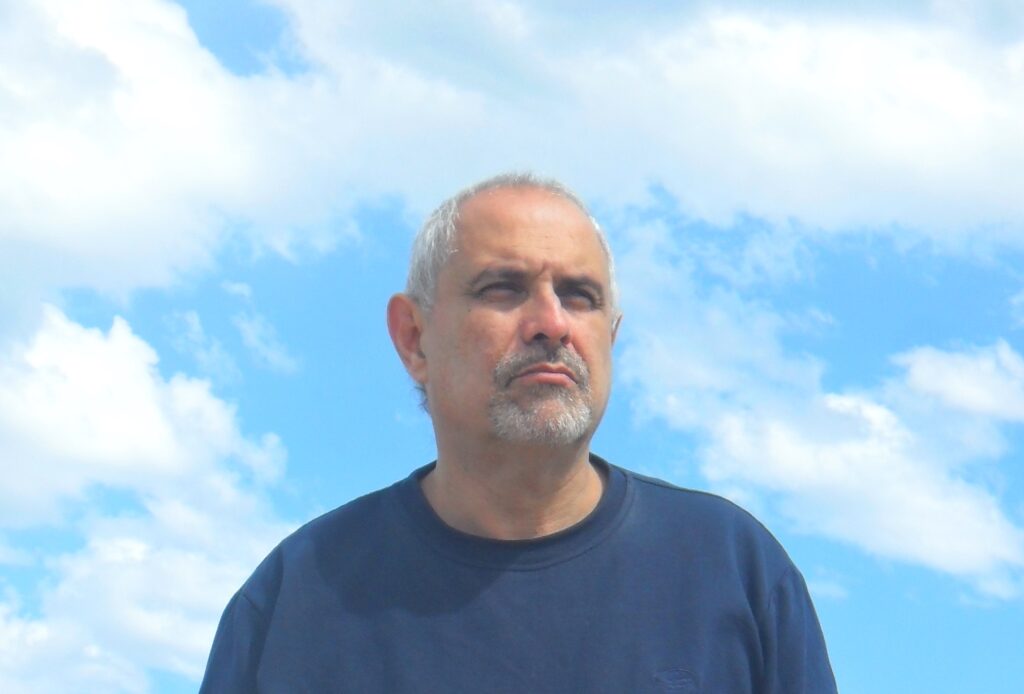
The author Carlos Ferguson works in the Educational area in the Province of Buenos Aires. He is also a professor of artistic drawing and has been dedicated to researching the UFO topic for 48 years, when, being a non-believer, he had a close encounter no more than 35 meters away with a disc-shaped UFO. He was the first civilian advisor in Ufology for the Argentine Air Force (2011 to 2017). He has courses in Satellite Technology, Remote Sensing and Geographic Information Systems. Author of 7 books and the largest compilation of landing cases in Argentina, with classified events. He has also carried out studies on cases of pilots and UFOs in Argentina, as well as underwater objects and the most recent, on the physiological and electromagnetic effects on witnesses. Hundreds of talks and notes over almost 5 decades show him with a line of work adjusted to the parameters of statistics.
Its partial or total reproduction is prohibited without the express authorization of the author.
QUOTES
QUOTE 2: “El nuevo desafío de los Ovni, J.C.Bourret – “Dos preguntas esenciales”, Dr.Claude Poher – Ate, Barcelona, 1978 – p.182)
QUOTE 3: “El nuevo desafío de los Ovni, J.C.Bourret – Ate, Barcelona, 1978 – p.225)
QUOTE 4: “The optical state of the atmosphere depends directly on the meteorological conditions; and the basic parameter for its description is the visual extinction coefficient.”

